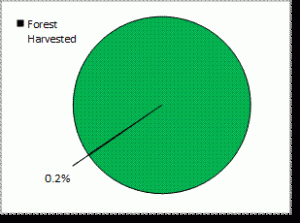When retailers started dropping plastic bags in favour of paper a few years ago, the Canadian Plastics Industry Association (CPIA) responded by labelling paper bags as “tree-hungry.” More recently, the lobby against Toronto’s proposed ban on plastic bags urged city councillors to “Save a tree. Reverse the bag ban.” Today, the pattern continues, with CPIA claiming that the plastic bag was invented “to protect trees and prevent clear-cutting of our forests.” [1]
So where are all those trees we are ‘killing’? Check out the thin black line in the sea of green below:

The line represents just how little of Canada’s commercial forest was actually harvested by the paper and lumber industries in the most recent year for which data is available. That’s the whole industry: timber for housing and construction; pulp and paper for newspapers; office supplies; tissue; and a tiny little bit for packaging grades. In total: less than 0.2%.
These are not our numbers. They come from Natural Resources Canada, the federal government department that’s charged with compiling an annual report on the state of Canada’s forests[2]. Here are some more inconvenient facts to consider:
- Over 70% of Canada’s forested area has never been harvested [3]
- Canada’s forest cover and wooded area has remained fairly constant over the past 20 years [4]
- Canada’s use of forest resources and protection of endangered species both received “A” grades in a recent comparative study of 17 countries [5]
- Some 38% of the world’s independent, third-party, certified forests are right here in Canada[6]
- One of the three Canadian mills that produces paper bag material uses predominantly recycled pulp (old corrugated boxes collected from the back of supermarkets and factories or from curbside) while the other two use wood chips and sawdust left over from sawmilling operations (for lumber production). For these mills, a fresh supply of tree material (to be shared with lumber) is only harvested when they can’t get enough chips and sawdust. All three mills are certified by internationally recognised, independent, third-party sustainable forest management programs[7].
Oh, and we almost forgot to mention that we don’t just “kill” trees, we also re-grow them. About 67% of the harvest is currently regenerated through tree planting and direct seeding (some 500 million seedlings per year or 1.4 million seedlings per day), while the remainder is regenerated naturally[8]. So basically the industry balances the harvest of the trees it needs, with the re-growth of the new forest. And according to Natural Resources Canada and the Conference Board, we’re doing a pretty good job of it.
So we have to ask: how are the plastic guys doing? Where’s their independent, third-party certification of how they extract their primary raw materials (crude oil and natural gas) from Alberta, China, or somewhere else? And how exactly do they plan to re-grow that oil and gas? Just asking.
[1]Clear-cutting is not the evil CPIA makes it out to be. It is recognised as a harvesting method by sustainable forest management standards such as PEFC, CSA, SFI and FSC. In its latest Sustainable Procurement Guide, the World Resources Institute and World Business Council for Sustainable Development acknowledges that “Clear-cutting can accomplish the following: it mimics some of the natural disturbance dynamics of the forests (e.g. fire, wind blow-downs, insects); in some ecosystems, it allows regeneration and rapid growth of certain tree species; it costs less; making forestry more economically viable; (and) it provides safer working conditions for loggers.” Sustainable Procurement of Wood and Paper-based Products, Version 3 Update December 2012, page 2.60 www.SustainableForestProducts.org
[2]Natural Resources Canada, The State of Canada’s Forests, Annual Report 2012, page 11. http://cfs.nrcan.gc.ca/pubwarehouse/pdfs/34055.pdf
[3]OECD, Environmental Performance Reviews: Canada (Paris: OECD, 2004) 85, quoted in Conference Board of Canada How Canada Performs, Use of Forest Resources, January 2013.
[4]Conference Board of Canada, How Canada Performs, Forest Cover Change, ibid.
[5]How Canada Performs, Use of Forest Resources, Threatened Species, ibid.
[6]Canadian Standards Association (CSA), Sustainable Forestry Initiative (SFI), Forest Stewardship Council (FSC). http://www.certificationcanada.org/english/status_intentions/status.php
[7]CSA, Programme for the Endorsement of Forest Certification (PEFC), FSC.
[8]Natural Resources Canada, ibid., National Forestry Database, 2010
